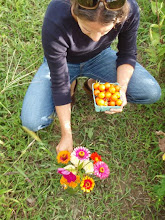
There's always a million excuses to indulge in a little something extra decadent, but thankfully these excuses are especially bountiful during the coldest winter months. It's been averaging somewhere in the low single digits around here, and in my book that provides a great reason to whip out the marscapone and make a pasta that I might usually pass on in months closer to shorts and tanks season. This is a quicky recipe from Food and Wine last month, and after tearing out the recipe the day it arrived in the mail, it only took me 2 days before I was roasting my wild mushrooms and watching with anticipation as the marscapone slowly melted into the pan, coating everything with a silky instant sauce.
I had a tough time finding buckwheat pasta, and briefly considering making it from scratch, but such ambitious ideas are quickly squashed on a weeknight. I ended up going with a dried chestnut tagliatelle I found at my local health food store, but by all means don't let a pasta hurdle keep you from making this. It would be delicious with any long, flat noodle (better to get coated in all that delicious creaminess).
Cheers to decadence! Hope you're keeping warm out there!
Creamy Buckwheat Pasta with Wild Mushrooms
Food and Wine, January 09
1/2 pound wild mushrooms, such as oysters and chanterelles, sliced in half lengthwise
2 tablespoons extra-virgin olive oil
Salt and freshly ground pepper
6 large eggs
1 pound buckwheat pappardelle
1 leek, white and light green parts only, halved and sliced 1/8 inch thick
1/4 cup plus 2 tablespoons mascarpone cheese
1/4 cup heavy cream (J Note: I used 1%)
3 tablespoons unsalted butter (J Note: I skipped this!)
1 1/2 cups baby spinach
Freshly grated Parmigiano-Reggiano cheese, for sprinkling
Preheat the oven to 400°. On a nonstick baking sheet, toss the mushrooms with 1 tablespoon of the olive oil and season with salt and pepper. Roast for 15 minutes.
In a medium pot of boiling salted water, cook the eggs for 5 minutes. Drain and cool under cold running water. In another pot of boiling salted water, cook the pasta until al dente and drain well.
In a medium skillet, heat the remaining tablespoon of olive oil. Add the leek and cook over medium heat until translucent. Reduce the heat to low and stir in the mascarpone and cream or milk, then stir in the butter, if using. Season with salt and pepper and remove from the heat.
Add the roasted mushrooms, cooked pasta and spinach to the skillet and toss to coat. Season with salt and pepper and mound the pasta into shallow bowls. Peel and halve the eggs, adding one to each bowl. Sprinkle the pasta with Parmigiano-Reggiano cheese and serve immediately.
















